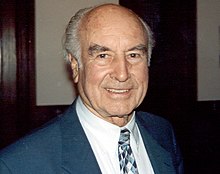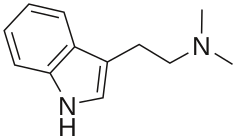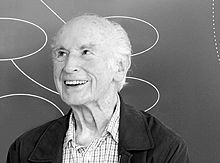Albert Hofmann
Albert Hofmann | |
|---|---|
 Albert Hofmann in 1993 | |
| Born | 11 January 1906 |
| Died | 29 April 2008 (aged 102) |
| Nationality | Swiss |
| Alma mater | University of Zürich |
| Known for | Synthesis of LSD-25 |
| Scientific career | |
| Fields | Chemistry |
| Part of a series on |
| Psychedelia |
|---|
 |
Albert Hofmann (11 January 1906 – 29 April 2008)[1][2] was a Swiss scientist known best for being the first person to synthesize, ingest, and learn of the psychedelic effects of lysergic acid diethylamide (LSD). Hofmann was also the first person to isolate, synthesize, and name the principal psychedelic mushroom compounds psilocybin and psilocin.[3] He authored more than 100 scientific articles and numerous books, including LSD: Mein Sorgenkind (LSD: My Problem Child).[2] In 2007, he shared first place, alongside Tim Berners-Lee, in a list of the 100 greatest living geniuses, published by The Telegraph newspaper.[4]
Life and career
Hofmann was born in Baden, Switzerland, the first of four children to factory toolmaker Adolf Hofmann and his wife Elisabeth (born Elisabeth Schenk). Owing to his father's low income, Albert's godfather paid for his education. When his father became ill, Hofmann obtained a position as a commercial apprentice in concurrence with his studies. At the age of twenty, Hofmann began his chemistry degree at the University of Zürich, finishing three years later, in 1929. His main interest was the chemistry of plants and animals, and he later conducted important research on the chemical structure of the common animal substance chitin, for which he received his doctorate, with distinction, in the spring of 1929.[5]
Regarding his decision to pursue a career as a chemist, Hofmann provided insight during a speech he delivered to the 1996 Worlds of Consciousness Conference in Heidelberg, Germany:
One often asks oneself what roles planning and chance play in the realization of the most important events in our lives. [...] This [career] decision was not easy for me. I had already taken a Latin matricular exam, and therefore a career in the humanities stood out most prominently in the foreground. Moreover, an artistic career was tempting. In the end, however, it was a problem of theoretical knowledge which induced me to study chemistry, which was a great surprise to all who knew me. Mystical experiences in childhood, in which Nature was altered in magical ways, had provoked questions concerning the essence of the external, material world, and chemistry was the scientific field which might afford insights into this.[6]
Discovery of LSD
Hofmann became an employee of the pharmaceutical-chemical department of Sandoz Laboratories (now a subsidiary of Novartis), located in Basel as a co-worker with professor Arthur Stoll, founder and director of the pharmaceutical department.[7] He began studying the medicinal plant squill and the fungus ergot as part of a program to purify and synthesize active constituents for use as pharmaceuticals. His main contribution was to elucidate the chemical structure of the common nucleus of the Scilla glycosides (an active principal of Mediterranean Squill).[7] While researching lysergic acid derivatives, Hofmann first synthesized LSD on 16 November 1938.[8] The main intention of the synthesis was to obtain a respiratory and circulatory stimulant (an analeptic) with no effects on the uterus in analogy to nikethamide (which is also a diethylamide) by introducing this functional group to lysergic acid. It was set aside for five years, until 16 April 1943, when Hofmann decided to reexamine it. While re-synthesizing LSD, he accidentally touched his hand to his mouth, nose or possibly eye, accidentally ingesting a small amount[9] and fortuitously discovered its powerful effects. He described what he felt as being:
... affected by a remarkable restlessness, combined with a slight dizziness. At home I lay down and sank into a not unpleasant intoxicated[-]like condition, characterized by an extremely stimulated imagination. In a dreamlike state, with eyes closed (I found the daylight to be unpleasantly glaring), I perceived an uninterrupted stream of fantastic pictures, extraordinary shapes with intense, kaleidoscopic play of colors. After some two hours this condition faded away.[10]
Three days later, on 19 April 1943, Hofmann intentionally ingested 250 micrograms of LSD. This day is now known as "Bicycle Day," because after starting to feel the effects of the drug as he rode home on a bike, and that became the first intentional acid trip.[11]
Further research
It gave me an inner joy, an open mindedness, a gratefulness, open eyes and an internal sensitivity for the miracles of creation. [...] I think that in human evolution it has never been as necessary to have this substance LSD. It is just a tool to turn us into what we are supposed to be.
— Albert Hofmann, Speech on 100th birthday[12]
Hofmann, later, was to discover 4-Acetoxy-DET (4-acetoxy-N,N-diethyltryptamine), also known as ethacetin, ethylacybin, or 4-AcO-DET, a hallucinogenic tryptamine. He first synthesized 4-AcO-DET in 1958 in the Sandoz lab. Hofmann became director of the natural products department at Sandoz and continued studying hallucinogenic substances found in Mexican mushrooms and other plants used by the aboriginal people there. This led to the synthesis of psilocybin, the active agent of many "magic mushrooms."[13] Hofmann also became interested in the seeds of the Mexican morning glory species Turbina corymbosa, the seeds of which are called ololiuhqui by the natives. He was surprised to find the active compound of ololiuhqui, ergine (LSA, lysergic acid amide), to be closely related to LSD.
In 1962, he and his wife Anita Hofmann (née Guanella, sister of Gustav Guanella, an important Swiss inventor) traveled to southern Mexico to search for the plant "Ska Maria Pastora" (Leaves of Mary the Shepherdess), later known as Salvia divinorum. He was able to obtain samples of this plant, but never succeeded in identifying its active compound, which has since been identified as the diterpenoid salvinorin A. In 1963, Hofmann attended the annual convention of the World Academy of Arts and Sciences (WAAS) in Stockholm.
Later years

Hofmann, interviewed shortly before his hundredth birthday, called LSD "medicine for the soul" and was frustrated by the worldwide prohibition of it. "It was used very successfully for ten years in psychoanalysis," he said, adding that the drug was misused by the Counterculture of the 1960s, and then criticized unfairly by the political establishment of the day. He conceded that it could be dangerous if misused, because a relatively high dose of 500 micrograms will have an extremely powerful psychoactive effect, especially if administered to a first-time user without adequate supervision.[14]
In December 2007, Swiss medical authorities permitted psychotherapist Peter Gasser to perform psychotherapeutic experiments with patients who suffer from terminal-stage cancer and other deadly diseases. Completed in 2011, these experiments represent the first study of the therapeutic effects of LSD on humans in 35 years, as other studies have focused on the drug's effects on consciousness and body.[15] Hofmann acclaimed the study, and continued to say he believed in the therapeutic benefits of LSD.[16] In 2008, Hofmann wrote to Steve Jobs, asking him to support this research; it is not known if Jobs responded.[17] The Multidisciplinary Association of Psychedelic Studies (MAPS) has supported research in the field of psychoanalysis using LSD, carrying on Hofmann's legacy and setting the groundwork for future studies.[18]
Hofmann was due to speak at the World Psychedelic Forum[19] from 21 to 24 March 2008 but was forced to cancel because of bad health.
Disposition of Hofmann's papers
After retiring from Sandoz in 1971, Hofmann was allowed to take his papers and research home. He gave his archives to the Albert Hofmann Foundation, a Los Angeles-based nonprofit, but the documents mostly sat in storage for years. The archives were sent to the San Francisco area in 2002 to be digitized, but that process was never completed. In 2013, the archives were sent to the Institute of Medical History in Bern, Switzerland, where they are currently being organized.[20]
Death
Hofmann died of a heart attack on 29 April 2008, surrounded by several grandchildren and great-grandchildren. He and his wife, Anita, who died in 2007, raised four children.[21]
Honors and awards
The Swiss Federal Institute of Technology (ETH Zurich) honored him with the title D.Sc. (honoris causa) in 1969 together with Gustav Guanella, his brother-in-law. In 1971 the Swedish Pharmaceutical Association (Sveriges Farmacevtförbund) granted him the Scheele Award, which commemorates the skills and achievements of the Swedish Pomeranian chemist and pharmacist Carl Wilhelm Scheele.[22]
See also
- Lysergic acid diethylamide
- History of lysergic acid diethylamide
- Psychedelic therapy
- Timothy Leary
- Owsley Stanley
- Drug design
- Alexander Shulgin
References
- ^ "Albert Hofmannf". Multidisciplinary Association for Psychedelic Studies. Archived from the original on 30 April 2008. Retrieved 29 April 2008.
{{cite web}}: Unknown parameter|deadurl=ignored (|url-status=suggested) (help) - ^ a b "Obituary: Albert Hofmann, LSD inventor". London: Daily Telegraph. 29 April 2008. Archived from the original on 1 May 2008. Retrieved 29 April 2008.
{{cite news}}: Unknown parameter|deadurl=ignored (|url-status=suggested) (help) - ^ Hofmann, A. "Psilocybin und Psilocin, zwei psychotrope Wirkstoffe aus mexikanischen Rauschpilzen." Helvetica Chemica Acta 42: 1557–1572 (1959).
- ^ "Top 100 living geniuses". The Daily Telegraph. London. 30 October 2007.
- ^ Dieter Hagenbach; Lucius Werthmüller; Stanislav Grof (2013). Mystic Chemist: The Life of Albert Hofmann and His Discovery of LSD (First English ed.). Santa Fe, NM: Synergetic Press. p. 16. ISBN 978-0-907791-46-1.
- ^ Hoffman, Albert; J. Ott (1996). "LSD: Completely Personal". Newsletter of the Multidisciplinary Association for Psychedelic Studies. 6 (3). Retrieved 7 November 2013.
- ^ a b "LSD, My Problem Child". psychedelic-library.org. Retrieved 16 November 2009.
- ^ Dr. Albert Hofmann; translated from the original German (LSD Ganz Persönlich) by J. Ott. MAPS-Volume 6 Number 69 Summer 1969
- ^ "LSD inventor Albert Hofmann dies". BBC News. 30 April 2008.
- ^ Hofmann 1980, p. 15
- ^ http://blog.oup.com/2013/04/bicycle-day-lsd-albert-hoffman/
- ^ "LSD: The Geek's Wonder Drug?". Wired.com. 16 January 2006. Retrieved 29 April 2008.
- ^ Bleidt, Barry; Michael Montagne (1996). Clinical Research in Pharmaceutical Development. Informa Health Care. pp. 36, 42–43. ISBN 0-8247-9745-0.
- ^ Smith, Craig S. (7 January 2006). "New York Times article". The New York Times.
- ^ "LSD-Assisted Psychotherapy for Anxiety". Multidisciplinary Association for Psychedelic Studies. 21 October 2011.
- ^ "The comeback of LSD – swissinfo.ch".
- ^ Weldon, Carolyne (17 August 2012). "Meet the Lab Coat-Clad Granddaddies of LSD". NFB.ca blog. National Film Board of Canada. Retrieved 17 August 2012.
- ^ "LSD-Assisted Psychotherapy for Anxiety". Multidisciplinary Association for Psychedelic Studies. 7 September 2011.
- ^ "World Psychedelic Forum".
- ^ Letzing, John. "LSD Archive Has Been on a Long, Strange Trip". Wall Street Journal. ISSN 0099-9660. Retrieved 20 October 2015.
- ^ Craig S Smith (30 April 2008). "Albert Hofmann, the Father of LSD, Dies at 102". The New York Times. Retrieved 2 May 2013.
- ^ "The Scheele Award" (PDF). The Scheele Award. Swedish Academy of Pharmaceutical Sciences. 2005. Retrieved 15 December 2013.
Further reading
- Horowitz, Michael. "Interview with Albert Hofmann", High Times (1976)
- Nathaniel S. Finney, Jay S. Siegel: In Memoriam – Albert Hofmann (1906–2008). Chimia 62 (2008), 444–447, doi:10.2533/chimia.2008.444
- Roberts, Andy. Albion Dreaming: A Popular History of LSD in Britain (2008), Marshall Cavendish, U.K, 978-1905736270/1905736274
- Hagenbach, Dieter and Lucius Werthmüller. Mystic Chemist: The Life of Albert Hofmann and His Discovery of LSD (Synergetic Press, 2013). ISBN 978-090779146-1
External links
- Albert Hofmann Foundation
- LSD: My Problem Child Career Autobiography
- Insight Outlook A book by Albert Hofmann
- Erowid: Albert Hofmann Vault
- Maps.org ("Stanislav Grof interviews Dr. Albert Hofmann")
- Albert Hofmann – Daily Telegraph obituary
- Watch Hofmann's Potion, a documentary on the origins of LSD
- Albert Hofmann's life and articles Template:Es icon
- LSD Returns—For Psychotherapeutics (Scientific American Magazine article)
- Albert Hofmann and Visionary Mushrooms – includes hand-written molecular structures of LSD and psilocybin by Dr. Hofmann
